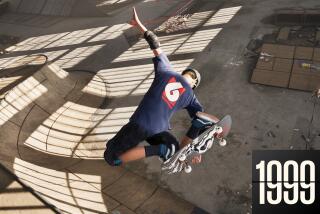Evolution on four fast wheels
You begin with a simple search for the toilet seat skateboard, the one mentioned on the International Surfing Museum website. This is core, you think. What could offer a better glimpse of skateboarding’s 50-year history than seeing its most essential piece of equipment constructed from the most essential piece of equipment in your house?
Regrettably, the museum doesn’t have one on display. But it’s a start, and if the goal is to offer young skaters a connection with the sport’s unvarnished roots, all resources should be exhausted.
The logical next step: Talk to Tony Hawk. Some experts will tell you that there’s a significant percentage of kids who actually think Hawk invented the sport. He didn’t, of course. It surfaced in the 1950s when Southern California surfers discovered it was a great way to get their fix when the waves weren’t pumping. But Hawk is indisputably the sport’s biggest name, and, at 36, he has seen skateboarding evolve from the backyard pool era to vertical ramps to today’s popular street skating.
So how important is it for young skaters to have some knowledge of what came before them?
“I don’t think it’s a requirement by any means,” says Hawk, who will skate Sunday at Pinz Bowling Center in Studio City at the Stand Up for Skateparks Benefit. “But I do think it would be interesting for kids to see what kind of boards they used to ride and what the focus was. When I started skating, the focus was how many 360s you could do. If kids saw someone today doing 360s, they just wouldn’t even be able to connect with it. It’s such a different style. It would be like they were watching ice skating.”
Replacing the 360 for today’s bragging rights, says Hawk, is the Ollie, a move invented by Alan Gelfand in 1978 in which riders pop the board in the air without using their hands. The Ollie served as a springboard to modern street skating, but it has given way to more complicated maneuvers, says Eric Stricker, editor of Transworld Skateboarding magazine.
“Now it’s about tricks where your board rotates 360 degrees in the air and does a flip at the same time, or how big a handrail you can board sled,” he says.
For those looking to sponge up skate history, Hawk suggests the Skatelab in Simi Valley, an indoor park that has a museum stocked with more than 2,000 boards. Skatelab’s co-owner, Todd Huber, says most kids blow right past the memorabilia, but the few who do slow down find plenty of intriguing gear. There’s a skate car known as a “coffin on wheels” that set a Guinness world record in the 1970s for the fastest gravity propelled human, and artwork from the influential 1970s Dogtown movement in Santa Monica, as well as the 1980s Bones Brigade, a team featuring Hawk that had an image so progressive that Huber says it looked as if it were “created in outer space.”
As much as anything, a trip to Skatelab reminds you just how far the equipment has come. The first boards were little more than 2-by-4s atop sawed-in-half roller skates, and early wheels were metal or clay, not the best mix with pebbles or cracks in the pavement.
“I don’t know if you’ve ever experienced concrete at speed, but it’s a bummer,” Huber says. “It hurts.”
The pain diminished in 1972 when Frank Nasworthy introduced the urethane wheel. From there, the sport entered a boom phase that lasted the remainder of the decade. Skate parks popped up nationwide and magazines emerged that highlighted stars such as Tony Alva and Jay Adams, members of the first pro team -- the Z-Boys. By the early ‘80s, liability issues had forced the closure of most parks, but Hawk led a new generation that raised the bar on tricks and aerials and kept the engine running. In 1995, after the sport hit another recession, skateboarding got its biggest mainstream exposure with the birth of the X Games, and, in 1998, skate parks made a comeback with the passage of a California law that limits a park’s liability by designating skateboarding as “hazardous.”
By all accounts, kids seeking a throwback experience should visit the recently opened public park in Glendale. Heavy on 1970s-style bowls rather than the rails, stairs, wedges and banks favored by the younger generation, it departs in a big way from standard parks. It also requires a different style and different skills, says Stricker, and it’s even more difficult if your board is set up for catching air.
“A lot of street skaters grow up riding boards with tightly fastened trucks, and it’s hard to turn,” he says. “In bowls, that’s not going to help you out. You need to have loose trucks to carve around and carry your speed through the transition.”
Those up for the challenge can ride retro at Vans Skatepark at the Block at Orange, where there’s an 11 1/2 -foot-deep Combi pool, or Upland Skate Park, another public facility that doesn’t charge admission.
Opened in 2002, Upland was designed to recapture the feeling of the original Upland park, which was bulldozed in 1988 and was, according to one online account, about the “gnarliest” skate park ever built. Like the first one, Upland’s big draw is a full pipe that offers a comparable ride to the drainage reservoir near Mt. Baldy that Stricker recently highlighted as one of the seven most important skate spots in California’s history. It beats the reservoir for smoothness, and it’s also legal. Since Mt. Baldy is federal property, skaters sometimes come home with a ticket.
If you’re planning on sampling old-school skating, you can warm up by renting “Dogtown and Z-Boys,” a 90-minute documentary chronicling skateboarding’s rise out of the Southern California surf culture. (Rough language, most of it bleeped, and Adams’ drug confessions account for the PG rating.) In the early days, skateboarding was a surfing spinoff, but Hawk says it soon took on its own identity.
“It evolved and the tricks got more complicated,” he says. “When people realized there were a lot of possibilities in terms of maneuvers, it started influencing surfing. It was spawned from surfing, but then it showed surfing what was possible.”
It also traveled off the coasts of Venice and Santa Monica and into the Inland Empire, home to another notable skate team known as the Badlanders, who congregated at Upland and the Baldy pipe.
“They don’t get the attention and the media coverage that the Z-Boys do, but they did just as much for skateboarding,” Stricker says. “It was a big thing to get three wheels over the top of the pool and then to get air. The Z-Boys started it, but the Badlanders continued it and really pushed it.”
Safe to say, very few kids who spend their spare time hopping curbs could tell you much about the Z-Boys or the Badlanders or the origins of the Ollie. When Huber gives tours of his museum, he asks visitors how long the sport has been around. Answers range from “three years” to “200.”
“It’s not that kids don’t care -- they just don’t know,” Huber says. “But I think it’s important to know where you came from. Because if certain things didn’t happen, skateboarding might have gone out with the Hula Hoop.”
Don Patterson can be reached at weekend@latimes.com
*
(BEGIN TEXT OF INFOBOX)
Where to roll
Where to go or learn about old-school skateboarding:
Glendale Skate Park, 1621 Canada Blvd., Glendale, (818) 548-2786
Vans Skatepark, 20 City Blvd. West, Suite A, Building 2, Orange, (714) 769-3800 or www.vans.com
Skatelab, 4226 Valley Fair St., Simi Valley, (805) 578-0040 or www.skatelab.com
Upland Skate Park, 1325 San Bernardino Road, Upland, (909) 931-4280
Southland skate park info:
www.SoCalSkateParks.com
*
Stand Up for Skateparks Benefit
What: Tony Hawk’s fundraiser for building public skateparks in low-income communities. “The cities that are telling kids not to skate, they’re not solving the problem,” Hawk says. “The only solution is to provide a place for them to go.” Hawk will co-host with Sean Penn. There will be skate demos by Hawk and other pros, and performances by Blink-182 and comedian David Spade.
When: 3 p.m. Sunday
Where: Pinz Bowling Center, 12655 Ventura Blvd., Studio City, (818) 769-7600 or www.pinzbowlingcenter.com
Price: $500 (adults with a ticket can admit one child free; each additional child’s ticket is $250.)
Contact: (310) 201-5033
More to Read
Go beyond the scoreboard
Get the latest on L.A.'s teams in the daily Sports Report newsletter.
You may occasionally receive promotional content from the Los Angeles Times.










